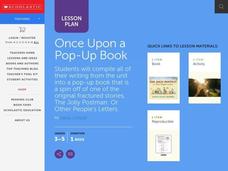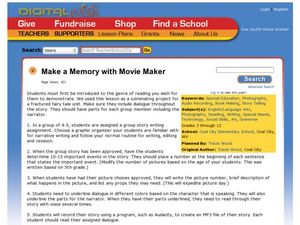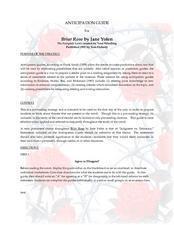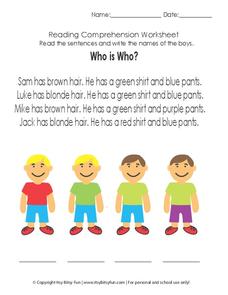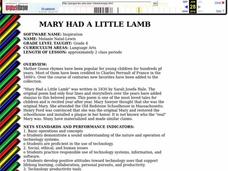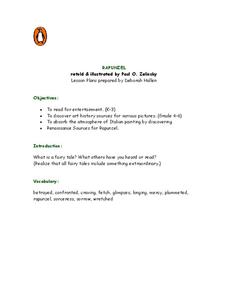State Library of Ohio
Tuck Everlasting
A great toolbox of ideas for any teacher preparing to teach the novel Tuck Everlasting by Natalie Babbitt, this resource includes a short biography of Natalie Babbitt, several discussion questions that could double as writing prompts,...
Curated OER
Once Upon a Pop-Up Book
Students design and illustrate a pop-up book of their original writing after studying the book, The Jolly Postman: Or Other People's Letter's. They present their book and complete a self-assessment rubric.
Curated OER
The Coin and the Fable: Alaska quarter reverse
An Alaskan quarter and a book of fables is what you'll need to start this lesson. Learners will use the image of the bear and the salmon found on the reverse side of the Alaskan quarter as inspiration. They will compose a fable about the...
McGraw Hill
Study Guide for Tuck Everlasting
Tuck Everlasting by Natalie Babbitt is a classic novel that readers have enjoyed for years. Resources within the study guide such as discussion and guided reading questions, extension activities, and graphic organizers aid comprehension...
Savvas Learning
Verbs: Future
As part of their study of future tense verbs, language learners engage in activities, read fables, and sing songs. The 25-page packet includes detailed lessons, worksheets, graphic organizers, and answer keys for assessments.
Curated OER
Make a Memory with Movie Maker
There is nothing more exciting than allowing learners to express themselves through a creative medium. In groups, they write narrative stories, focusing on building a strong storyline and dialogue. Next, they transform their stories into...
Curated OER
Applying Ahimsa to Traditional Stories
Investigate the life of Mahatma Gandhi by researching non-violent lifestyles. Learners define the word ahimsa and discuss the personal characteristics that made Gandhi a peaceful warrior. They also create a poster about the story "The...
Curated OER
Story Pyramids
Young writers generate descriptive words. They use pictures of various landscapes (from books, magazines, or the Internet) and complete a story pyramid. The pyramid (included here) asks to describe the main character, the setting, and...
Curated OER
Idioms
Use this podcast lesson plan to familiarize scholars with the characteristics, history, and cultural implications of idioms. As part of the Walking Classroom curriculum, kids listen to a 12-minute podcast as they walk around campus. If...
Curated OER
Briar Rose: Anticipation Guide
Prepare your readers for Briar Rose with an Anticipation Guide that asks them to agree or disagree with a series of statements that reflect issues raised by Jane Yolen’s narrative about a young girl’s research into her grandmother’s...
Curated OER
KWHL Questioning Strategy for Briar Rose
Whether new to the KWHL strategy or not readers of Briar Rose will benefit from the detailed procedures and templates designed for Jane Yolen’s novel. Links are provided for research into the Holocaust and activities reveal the many...
Curated OER
Unsent Letter: Characterization in Briar Rose
After completing Jane Yolen’s Briar Rose, class members assume the voice of Gemma and craft a personal letter to her granddaughter telling Becca how she feels about Becca’s actions and the discoveries at Chelmno. Complete directions for...
National Endowment for the Humanities
A Wrinkle in Time: The Board Game
Tackle some big questions about A Wrinkle in Time by Madeleine L'Engle with a board game project. As learners brainstorm for and complete their board games, they consider what helps and hinders Meg on her journey and why she succeeds in...
Itsy Bitsy Fun
Reading Comprehension Worksheet: Who is Who?
Primary graders read short passages and then respond to a series of questions on these comprehension worksheets.
Curated OER
Goldilocks and the Library Media Center
Third graders explore the library media center using the characters and story of "Goldilocks and the Three Bears" by James Marshall. They discuss what rules Goldilocks would need to follow in the library, complete a sequence chain for...
Curated OER
Using Cinderella Stories to Study Venn Diagrams
Seventh graders read Cinderella stories and complete graphic organizers for the various versions. In this story analysis lesson, 7th graders read versions of the story Cinderella. Students organize the story's information using a variety...
Curated OER
Mary Had A Little Lamb
Fourth graders listen and observe the role play of the various versions of the poem. They take notes while listening and observing and develop their own versions of "Mary Had a Little Lamb".
Curated OER
Classic Storytelling with a Technology Twist
Students use technology to improve their knowledge of literary terms, math, and technology skills. In this technology storytelling lesson, students learn about character, plot, and setting in various stories by using technology like...
Curated OER
La Cenerentola (Cinderella)
Students are introduced to the composer, Gioacchino Rossini, and discuss his life and musical culture.
Curated OER
A "Tail" to Tell
Young scholars write a sequel to the original The Three Little Pigs story or a fractured version of it and share it with classmates.
Curated OER
Having a Ball With Cinderella
Students read and discuss two versions of the story, Cinderella. They complete a Venn Diagram to compare and contrast the two stories and move to music based on the two versions. They use the internet to gather more information about...
Curated OER
Examining Persuasive Literature
Examine persuasive literature and writing. In this persuasive literature lesson, pupils work through a variety of activities over the course of three weeks (each week is planned by day). The unit's purpose is to examine examples of...
Curated OER
Rapunzel
Youngsters read the story of Rapunzel and go over vocabulary and answer discussion questions. They also list qualities of characters, discuss settings, make a diorama, and more.
Curated OER
Using Quotation Marks: Around Titles of Short Works
When do you use quotation marks around titles? Review the rules at the top of the page, and then let learners decide if the sentences that follow use the quotations correctly. An answer sheet is included.



